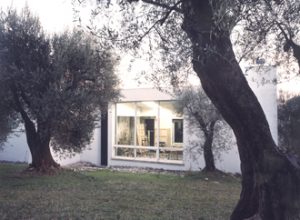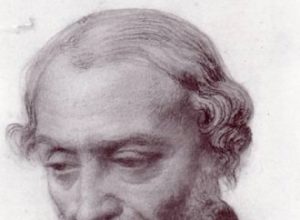In a Germany exiting from Nazism, Joseph Beuys was effectively able to capture the attention of the public and the media by going back over the recent catastrophe. His spectacular return upon these events has meaning only when one recalls the violent world in which he had himself participated. Indeed, he set out to resurrect the German artistic and political scene by identifying with the figure of Christ in a process of atonement that, according to a hijacked Romantic tradition, confided upon the artist a sacred mission.
Everyone will see in this effort what he wants to see therein. For his loyal supporters, it marks the sincere mourning process of a German who had fought in the Wehrmacht, a contemporary magus and guardian of a higher knowledge, an enemy of the materialism of capitalist society, and a great teacher driven by a spirit of provocation who was able to reinvent his own history for others’ use. For his critics, this effort constitutes the wily construction of an advantageous new national identity just as Germany was wiping out Nazi history with the economic miracle of the Federal Republic, as well as the birth of a new type of political artist-guru who assiduously enlists his public through the use of hackneyed archetypes: from native soil to the Germanic language–extended to the Celtic family–the only one endowed with the power of regeneration. In other words, Beuys is the author of a symptomatic work, one born of a wartime traumatism and of a national-Romantic ideology that fails to free itself from its own heroic particularism.
These two positions are represented here: the latter by Maïté Vissault, author of an excellent dissertation that is forthcoming on La problématique de l’identité allemande à travers la réception de l’oeuvre de Joseph Beuys (The problematic of German identity examined through the reception of Joseph Beuys’s work); the former by Jean-Philippe Antoine, whose work on Beuys will soon be published.
Their respective points of view are practically irreconcilable, so much do the methods of analysis diverge, thereby bringing out major conceptual differences about art and its function in society.
Laurence Bertrand Dorléac
Seminar of April 26nd 2007
Is it possible to consider the reception of an artist’s work while economizing on the analysis of its material construction, which also implies the construction of the public that receives it? That is the main question Maïté Vissault’s text raises.
While the picture she sketches of the ways in which Beuys was used by the media and in the milieu of German art, and still more by the cultural apparatuses of the FRG, is plausible and interesting, it is also haunted by a black hole: the reason that made possible this utilization, indeed this exploitation–which the artist, it is useful to recall, himself cunningly knew how to find a way around, by participating directly in its modeling.
I. Training and Teaching
How did Beuys train, how did he “break in” a public for his work–the success of which, including at the institutional level, was rather late (his first one-man show was at age forty-three)? By what means? At least in the 1960s and in the early 1970s, he did so through several “scandalous” events–for example, the Aix-la-Chapelle Festival in July 1964–which staged, quite head-on, the question of the reception of his work at the same time that they questioned the relation of the artist to the cultural and educational institutions hosting them. From this standpoint, it may be regretted that Maïté Vissault mentions only in passing, with one mere word–professor–Beuys’s intense teaching activity between 1961 and 1972 (or 1976, if one includes his unofficial activity before his reinstatement, after a famous trial) at the Düsseldorf Academy of Art, no doubt the most important arts-education institution in Germany (incidentally, Beuys had been one of the first students there right after the war). Without this activity and the provocative forms it could take on, we would be very hard pressed to understand the prestige and authority the artist enjoyed, up to and including his commercial success.
Thus presented a posteriori and separated from the initial circumstances of his reception, the Beuys “case” ceases to be one. He does not differ from the other German artists mentioned–Kiefer, Baselitz, or Polke–all of whom were born, however, between 1938 and 1945 and therefore unscathed by any active exposure to the Nazi regime (a word that, with enormous euphemism, does not even appear in the text!). Now, if Beuys’s work has experienced such a great impact, that is first of all because, with his actions and installations–unprecedented means (though highly indebted to Duchamp, as the author rightly recalls, which explains in part Beuys’s silence about France)–he succeeded in confronting a public that had largely refused to face up to its memories of Nazism and the war; for, with its spellbound will to join in the reconstruction and economic success of the Federal Republic, this public had until then sought refuge in the FRG’s forgetful normality. This is what, without necessarily capturing the force of the Beuysian operation, Benjamin Buchloh had perfectly well grasped and brought out.
II. Constructing a Public Memory
In this sense, what Beuys rediscovered was not a “German history” that indiscriminately mixed together Goethe, Schiller, and their gravedigger Wagner (for whom, contrary to a persistent legend, Beuys felt no affection, as his penchant, by way of contrast, for Erik Satie confirms). What he rediscovered was his childhood and his adolescence under Nazism and his own involvement in its warrior dream. But this “rediscovery,” with its shocking intimacy, was also, and first of all, an unprecedented public construction. Consequently, Beuys’s legacy, as anchored as it might be in his individual biography and in a German problematic, is perceptible above all in the forms of work he was able to invent, to adapt, and to make available for numerous artists of today who take inspiration therefrom, just as the work of Joyce–a “practical” hero for Beuys just as much as Duchamp was–exists first of all as a fictional construction and powerfully accounts, on the basis of these fictions, for the reality memory simultaneously intends and constructs–the memory, that is, of the author as well as that of his readers. Here we have a technique for involving the reader/viewer that quite immediately raises the question of reception, including collective reception, of the work, but that also prevents one from separating it from the technical means superintending it.
III. The European Beuys: Joyce and Duchamp
Now, these means are far from specifically German. They are the work of artists who are eminently international just as they are eminently in the minority. Apart from the aforementioned “Franco-American” maverick Duchamp, we are talking here about Fluxus, that amorphous cluster to which Beuys was not always “vaguely” attached, even if his involvement was limited in time and even if his projects were considered dissident in relation to those of the movement’s main organizer, George Maciunas. On this topic, it is important to recall that the presence of American artists in Germany in the late 1950s and early 1960s was, on the one hand, tied to the existence of American military bases and was, on the other hand, that of artists who came to find (or thought they had found) in Europe the minimum of acceptance needed to pursue activities quite ill regarded or very lightly regarded in their home country. Beuys’s contemporary America was therefore the America of Cage or Maciunas, and even (belatedly) that of Warhol, as against the architects of the Vietnam War, as against the machinations of Reaganites whom he was to denounce in song in the early 1980s, or even as against most of its cultural institutions (from which his works are still today almost completely absent), with the significant exception of a few teaching establishments (his lecture at the New School in New York in 1974).
IV. A Career Path
It is not only possible, it is advisable to examine the reception of Beuys’s work. But that presupposes, it seems to me, that one start with an examination of the artistic communicational techniques his work implements rather than, as here, the examination of its separate existence in the media or cultural institutions. In order to pursue the parallel set out above, how is one to speak of Joyce’s Ireland without taking into account not only his local roots but also the construction techniques employed by the writer to portray places he had not seen again since he began to portray them in his writing? Why, from Dubliners to Ulysses, without even mentioning Finnegans Wake (another favorite work of Beuys’s), did Joyce have to reinvent each time unprecedented means in order to retell us about Ireland, its crises, its struggles, its political partition, and in order to build an altogether new as well as real Ireland? Why did Beuys pass from the Neo-Expressionist drawings and bas-reliefs of his postwar years to Fat Chair (a somewhat shapeless heap of margarine set on a used kitchen chair) or to such Actions as Eurasia? From Eurasia to 7000 Oaks? But also, how does the Fat Chair become an acceptable “German” image? And acceptable for whom? Did the action 7000 Oaks have the same public as Eurasia?
The public for Beuys’s work did not exist before the work itself; and until around 1968-1970, that public was numerically and “politically” very limited. How did the construction of this public proceed? What role did this personality’s speeches and public appearances play in this construction? How did the written press, radio, and television relay or distort Beuysian statements? What did the gradual and partial introduction of Beuysian images into the public sphere produce within the cultural-political image of the country that the Federal and regional authorities were seeking to promote? And to what extent was Beuys’s more strictly political activism, starting in the mid-1970s, a reaction to the proliferation and partial neutralization of the images he had been able to construct in an at once more limited and more polemical context? To what extent were these images an attempt to escape the “mythical” artistic image projected via media coverage of him?
These are all questions that involve the reception of the work qua active process of its constitution as well as the examination of its status as public object. But they also are all questions that, it seems to me, necessarily involve taking account of the ways of doing invented by the artist, who undid any effort at mythical construction, unlike–and against–the totalitarian culture in which he had been immersed as a youth.
Duchamp already made of the creative process the dynamic encounter between the share of unconsciousness the artist deposits in his objects and the share the often unconscious action of his various publics, confronted with these objects, invents and reveals in them. The Beuysian slogan “Every human being is an artist” takes over and extends Duchampian conclusions. Can an analysis of the reception of his work economize on this dimension without letting slip away the very reason why it became an element of our public life? At his own risk, the author of these lines has his doubts.
Jean-Philippe Antoine, a philosopher and artist, teaches aesthetics at the Jean Moulin-Lyon 3 University. His work investigates the relationships between image and memory and the modern status of art. He has recently published Marcel Broodthaers: Moule, muse, Méduse (Dijon: Presses du Réel, 2006), Gerhard Richter: Landscapes (New York: Zwirner & Wirth, 2004), and Six rhapsodies froides sur le lieu, l’image et le souvenir (Paris: Desclée de Brouwer, 2002). His book La traversée du XXe siècle: Joseph Beuys, Image, Mémoire is forthcoming from MAMCO (Geneva).



